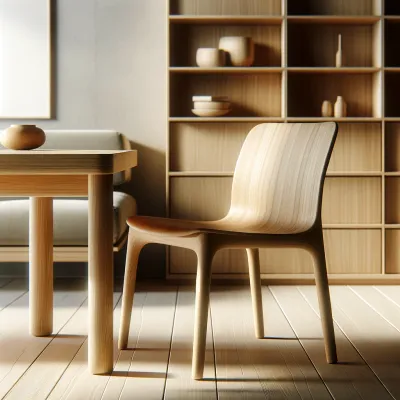Eco-Friendly Woods for Modern Design
The modern design landscape is increasingly turning green, embracing materials that are not just aesthetically pleasing but also environmentally responsible. Among these, wood stands out as a timeless favorite. However, not all woods are created equal when it comes to sustainability. This blog post delves into the world of eco-friendly woods, highlighting those that bring both beauty and environmental consciousness to modern design.
What Makes Wood Eco-Friendly?
- Sustainable Forestry Practices
- Responsible Harvesting: Eco-friendly wood comes from forests where trees are harvested responsibly. This means cutting down trees at a rate that doesn't exceed their natural regrowth capacity.
- Certification Standards: Look for woods certified by organizations like the Forest Stewardship Council (FSC) or Programme for the Endorsement of Forest Certification (PEFC). These certifications ensure the wood is sourced from well-managed forests.
- Impact on Natural Habitats
- Biodiversity Preservation: Sustainable wood sourcing includes measures to protect the biodiversity of the forest. This means avoiding the destruction of ecosystems and habitats of endangered species.
- Soil and Water Conservation: Eco-friendly wood sourcing practices also involve protecting the soil and water quality in the forest area, ensuring a healthy ecosystem.
- Replenishment and Regrowth Initiatives
- Reforestation Efforts: After harvesting, efforts are made to replant trees, either manually or by natural regeneration, to ensure the forest can continue to thrive.
- Long-term Forest Management: Sustainable forestry isn't just about planting new trees. It includes managing the forest for the long term, considering future generations.
- Low Environmental Footprint
- Reduced Carbon Footprint: Trees absorb carbon dioxide, and by using wood from sustainable sources, the carbon stored in the wood is retained, reducing the overall carbon footprint.
- Energy-Efficient Processing: The processing of eco-friendly woods often requires less energy compared to other building materials, contributing to a lower environmental impact.
- Community and Social Responsibility
- Support for Local Communities: Sustainable wood sourcing often involves supporting the local communities that depend on the forest for their livelihood, ensuring fair labor practices and economic stability.
- Educational Initiatives: Many sustainable forestry programs include educational aspects, teaching communities and industry professionals about sustainable practices and environmental stewardship.
By understanding these factors, we can appreciate the importance of choosing eco-friendly woods in modern design. These materials not only bring aesthetic and functional value to projects but also support a much larger commitment to environmental health and ethical responsibility.
Top Eco-Friendly Woods for Modern Design
- Bamboo: The Rapid Renewer

- Features: Fast growth, versatility, strength
- Reclaimed Wood: Beauty with History

- Advantages: Unique character, recycling old wood, reducing waste
- Cork: More Than Just Bottle Stoppers

- Benefits: Renewable harvesting, versatility in design
Lesser-Known Sustainable Options
- Mango Wood: From Fruit to Furniture

- Highlights: Utilizing non-fruit bearing trees, unique grain
- Rubberwood: An Unsung Hero

- Features: Durability, repurposing from rubber industry

The Impact on the Environment and Beyond
Carbon Sequestration:Woods like bamboo and cork are highly effective at sequestering carbon, thus playing a significant role in combating climate change. Sustainable forestry practices ensure that this benefit is maximized.
Reduced Deforestation: By choosing eco-friendly woods, the demand for wood from unsustainable sources is decreased, which in turn helps in reducing deforestation and its associated negative impacts on the environment.
Supporting Sustainable Livelihoods:Eco-friendly wood industries often support fair trade practices, ensuring that workers and local communities are treated ethically and paid fairly.
Promoting Local Economies: Sustainable wood sourcing can bolster local economies, especially in rural areas where such activities might be a primary source of income.
Supply Chain Transparency:One of the significant challenges is ensuring transparency throughout the supply chain, from harvesting to the final product. This includes tracking the origin of the wood and ensuring all processes meet sustainability standards.
Cost Factors: Often, eco-friendly wood products can be more expensive than their non-sustainable counterparts, primarily due to the more involved and ethical practices. This can be a barrier for consumers and manufacturers.
Advancements in Forestry Management:Technology plays a crucial role in sustainable forestry, from satellite monitoring of forests to innovative methods in wood processing that reduce waste.
Developing Alternatives: Research into alternative materials and wood composites is expanding, offering potentially more sustainable options while reducing pressure on natural forests.
Educating Consumers:There's a growing need to educate consumers about the importance of choosing sustainable products and the impact of their choices on the environment.
The Power of Demand:Consumer demand for eco-friendly products can significantly influence manufacturers and suppliers, pushing the industry towards more sustainable practices.
Regenerative Practices: Looking beyond sustainability to regenerative practices that not only minimize harm but actively improve environmental conditions.
Policy and Regulations:The potential for more robust policies and regulations that mandate sustainable practices in forestry and wood manufacturing.
By exploring these areas in greater depth, we can gain a more nuanced understanding of the role eco-friendly woods play in modern design. It’s about balancing aesthetics, functionality, and most importantly, our responsibility towards the planet and future generations. The use of sustainable woods isn't just a design choice; it's a statement about our values and commitment to a healthier, more equitable world.

Eco-friendly woods are not just a trend; they are a crucial part of the future of design and environmental stewardship. By choosing sustainable options, designers and consumers alike can make a significant impact. As we move forward, the integration of beauty, functionality, and responsibility will continue to shape the world of modern design. Let's build a greener future, one piece of wood at a time.



